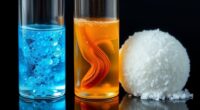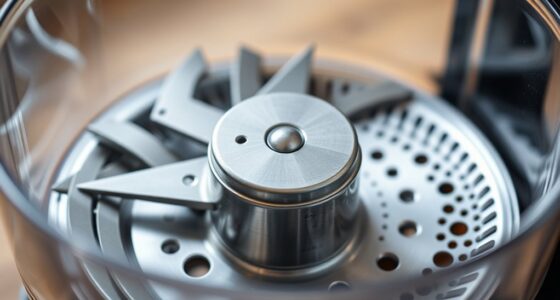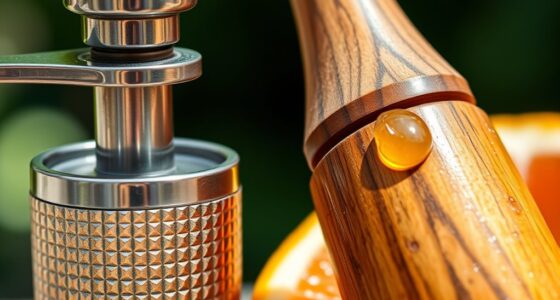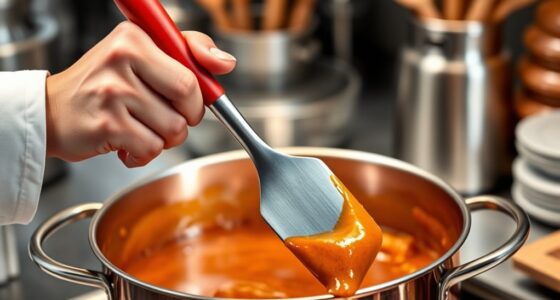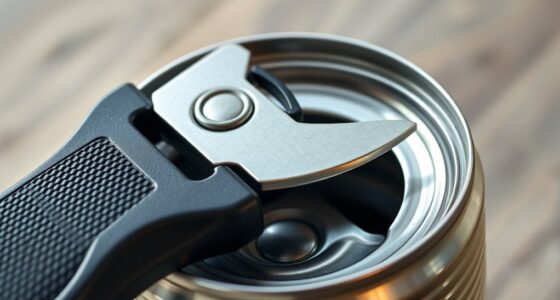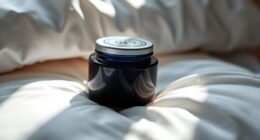Silicone baking mats are great when you want a reusable, non-stick surface for baking cookies, pastries, or roasting vegetables, and they work well in the oven up to high temperatures. However, avoid using them if you need a crispy crust or browning, such as for bread or pizza, since the mats prevent direct heat contact. For detailed tips on their best use and limitations, keep exploring to make sure you’re using them effectively.
Key Takeaways
- Use for baking cookies, pastries, and roasting vegetables to ensure even heat distribution and easy cleanup.
- Avoid using for bread or tasks requiring a crispy crust, as silicone mats inhibit browning and caramelization.
- Ensure the mat fits well on your baking sheet; improper sizing can affect baking results.
- Do not use on direct flames, broilers, or under high heat beyond the mat’s recommended temperature.
- Regularly clean and inspect the mat to prevent stains or odors, especially after oily or spicy foods.
Silicone baking mats have become a popular kitchen essential for both novice and experienced bakers. They offer a reusable, non-stick surface that simplifies baking and cleanup. When you’re preparing cookies, pastries, or roasted vegetables, these mats can be a game-changer, eliminating the need for parchment paper or cooking sprays. Their flexibility and durability let you line baking sheets effortlessly, providing even heat distribution and preventing sticking. Plus, since they’re heat-resistant up to high temperatures, you can use them in the oven without worry. If you’re someone who bakes frequently or wants to reduce waste, silicone mats are an excellent investment. They’re also easy to clean—simply rinse or wash with soap, and they’re ready for your next batch.
However, there are times when silicone baking mats might not be the best choice. For example, if you’re aiming for a crisp or browned crust on bread or certain pastries, a silicone mat might inhibit that process. Silicone’s non-stick nature means it doesn’t promote the caramelization or browning that some recipes require. In such cases, using a traditional baking sheet or a perforated pan could give you better results. Additionally, if you’re baking something that needs direct contact with a hot surface to develop a crust, like certain bread or pizza, placing a silicone mat underneath might prevent the necessary heat transfer. Over time, some mats can develop stains or odors, especially if you bake strongly spiced or oily foods frequently, so you might prefer other options for certain dishes.
Another consideration is the size and thickness of your silicone mat. Thinner mats may deform or scorch at very high temperatures, while thicker ones might be less flexible for certain baking tasks. Also, if your baking sheet isn’t perfectly flat or has uneven edges, the silicone mat might not sit evenly, which could affect your baking. While they’re generally safe for oven use, you shouldn’t use silicone mats on direct flame or under broilers, as high heat beyond their capacity can damage the material. For foods that require direct contact with the heat source, like broiled dishes or searing, sticking with traditional methods is preferable. Additionally, proper maintenance of silicone mats can extend their lifespan and ensure safe use over time.
Frequently Asked Questions
Can Silicone Baking Mats Be Used on Induction Cooktops?
No, silicone baking mats shouldn’t be used directly on induction cooktops. They aren’t designed to withstand direct heat from stovetop surfaces, and doing so could damage the mat or your cooktop. If you want to protect your induction surface, use a heat-resistant, flat tray or pan approved for stovetop use. Always follow manufacturer instructions to avoid accidents or damage.
Are Silicone Baking Mats Safe for Microwave Use?
Yes, silicone baking mats are safe for microwave use. You can place them in the microwave to heat or defrost food without worrying about harmful chemicals or melting. Just make certain the mat is labeled microwave-safe, and avoid using it for high-temperature cooking or grilling, as prolonged exposure to high heat can damage the silicone. Always follow the manufacturer’s instructions for safe and effective use.
How Do Silicone Mats Affect Baked Goods’ Texture?
Think of silicone mats as the magic wand of baking, transforming your treats. They give your baked goods a consistent, even crust without sticking, keeping the texture light and crisp. However, they can sometimes produce a slightly softer bottom compared to traditional baking sheets, especially if used at lower temperatures. Overall, they enhance your baking experience by providing a non-stick surface, but be mindful of the slight change in crust firmness.
Can Silicone Baking Mats Be Reused After Staining?
Yes, you can reuse silicone baking mats after staining. stains typically don’t affect their performance or safety. To keep them looking good, wash the mats with warm, soapy water or gently scrub with a soft sponge. Avoid harsh abrasives or sharp tools that could damage the surface. Proper cleaning helps maintain their non-stick qualities and extends their lifespan, so you can enjoy baking with them for many uses to come.
Do Silicone Mats Release Any Harmful Chemicals?
Silicone mats are like silent guardians in your kitchen, but you might wonder if they release harmful chemicals. Rest assured, high-quality silicone mats are made from food-grade silicone, which is non-toxic and stable at high temperatures. They don’t emit fumes or chemicals during use. Just make sure to choose mats approved by food safety standards, and you’ll enjoy safe, reusable baking without worries about harmful substances leaching into your food.
Conclusion
Silicone baking mats are your trusty allies in the kitchen, making baking easier and cleaner. But remember, like any tool, they’re not always the best choice—sometimes, traditional methods shine brighter. So, will you embrace their convenience or stick to your usual routine? The decision is yours, and the choice is clear: with the right tools, every baking adventure becomes a story worth savoring. After all, isn’t it the perfect balance that makes baking truly magical?
